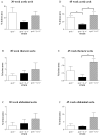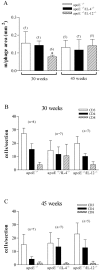The role of interleukin-4 and interleukin-12 in the progression of atherosclerosis in apolipoprotein E-deficient mice
- PMID: 12937153
- PMCID: PMC1868277
- DOI: 10.1016/S0002-9440(10)63471-2
The role of interleukin-4 and interleukin-12 in the progression of atherosclerosis in apolipoprotein E-deficient mice
Abstract
Accumulation of T cells and macrophages in atherosclerotic plaques and the formation of antibodies directed against plaque proteins suggests that adaptive immunity contributes to the development of atherosclerosis. The contribution of Th1 and Th2 helper cell subsets to atherogenesis was studied in a murine model by interbreeding apolipoprotein E-deficient (apoE(-/-)) mice with mice deficient in key cytokines that drive either Th1 responses [interleukin (IL)-12] or Th2 responses (IL-4). Compared to apoE(-/-) mice, apoE(-/-)/IL-12(-/-) mice had a 52% reduction in plaque area in the aortic root at 30 weeks of age (P < 0.001). ApoE(-/-)/IL-4(-/-) mice had a 27% reduction in plaque area compared to apoE(-/-) mice (P < 0.05) at 30 weeks of age, but their plaques were significantly larger than in apoE(-/-)/IL-12(-/-) mice at this stage (P < 0.05). By 45 weeks of age, there were no significant differences in lesion sizes in the aortic root between the strains, however apoE(-/-)/IL-4(-/-) mice showed a 58% and 64% decrease in disease in their aortic arch compared to apoE(-/-) (P < 0.05) and apoE(-/-)/IL-12(-/-) (P < 0.05) mice, respectively, and a 78% decrease in thoracic lesions compared to apoE(-/-)/IL-12(-/-) (P < 0.05). This suggests that both Th1 and Th2 cytokines play roles throughout the development of atherosclerosis in various vascular sites in apoE(-/-) mice.
Figures




Similar articles
-
Increased atherosclerotic lesions and Th17 in interleukin-18 deficient apolipoprotein E-knockout mice fed high-fat diet.Mol Immunol. 2009 Nov;47(1):37-45. doi: 10.1016/j.molimm.2008.12.032. Epub 2009 Feb 8. Mol Immunol. 2009. PMID: 19201478
-
Interleukin-1 receptor signaling mediates atherosclerosis associated with bacterial exposure and/or a high-fat diet in a murine apolipoprotein E heterozygote model: pharmacotherapeutic implications.Circulation. 2004 Sep 21;110(12):1678-85. doi: 10.1161/01.CIR.0000142085.39015.31. Epub 2004 Sep 7. Circulation. 2004. PMID: 15353494
-
Lesion development and response to immunization reveal a complex role for CD4 in atherosclerosis.Circ Res. 2005 Mar 4;96(4):427-34. doi: 10.1161/01.RES.0000156889.22364.f1. Epub 2005 Jan 20. Circ Res. 2005. PMID: 15662027
-
New insights into immunological aspects of atherosclerosis.Pol Arch Med Wewn. 2008 Mar;118(3):127-31. Pol Arch Med Wewn. 2008. PMID: 18476459 Review.
-
[Interleukin-10 and coronary disease].Rev Esp Cardiol. 2002 Jul;55(7):738-50. doi: 10.1016/s0300-8932(02)76693-1. Rev Esp Cardiol. 2002. PMID: 12113702 Review. Spanish.
Cited by
-
CD1d-dependent activation of NKT cells aggravates atherosclerosis.J Exp Med. 2004 Feb 2;199(3):417-22. doi: 10.1084/jem.20030997. Epub 2004 Jan 26. J Exp Med. 2004. PMID: 14744994 Free PMC article.
-
IL-5 links adaptive and natural immunity specific for epitopes of oxidized LDL and protects from atherosclerosis.J Clin Invest. 2004 Aug;114(3):427-37. doi: 10.1172/JCI20479. J Clin Invest. 2004. PMID: 15286809 Free PMC article.
-
Increased Level of Tim-3+PD-1+CD4+T Cells With Altered Function Might Be Associated With Lower Extremity Arteriosclerosis Obliterans.Front Immunol. 2022 Jun 10;13:871362. doi: 10.3389/fimmu.2022.871362. eCollection 2022. Front Immunol. 2022. PMID: 35757718 Free PMC article.
-
The influence of innate and adaptive immune responses on atherosclerosis.Annu Rev Pathol. 2014;9:73-102. doi: 10.1146/annurev-pathol-020712-163936. Epub 2013 Aug 7. Annu Rev Pathol. 2014. PMID: 23937439 Free PMC article. Review.
-
Cytokines and atherosclerosis: a comprehensive review of studies in mice.Cardiovasc Res. 2008 Aug 1;79(3):360-76. doi: 10.1093/cvr/cvn120. Epub 2008 May 16. Cardiovasc Res. 2008. PMID: 18487233 Free PMC article. Review.
References
-
- Xu QB, Oberhuber G, Gruschwitz M, Wick G: Immunology of atherosclerosis: cellular composition and major histocompatibility complex class II antigen expression in aortic intima, fatty streaks, and atherosclerotic plaques in young and aged human specimens. Clin Immunol Immunopathol 1990, 56:344-359 - PubMed
-
- Hansson GK, Jonasson L, Lojsthed B, Stemme S, Kocher O, Gabbiani G: Localization of T lymphocytes and macrophages in fibrous and complicated human atherosclerotic plaques. Atherosclerosis 1988, 72:135-141 - PubMed
-
- Van Der Wal AC, Das PK, Bentz Van De Berg D, Van Der Loos CM, Becker AE: Atherosclerotic lesions in humans: in situ immunophenotypic analysis suggesting an immune mediated response. Lab Invest 1989, 61:166-170 - PubMed
Publication types
MeSH terms
Substances
LinkOut - more resources
Full Text Sources
Other Literature Sources
Molecular Biology Databases
Miscellaneous

